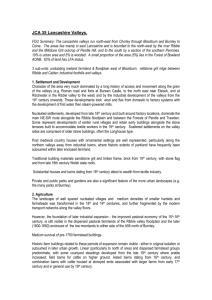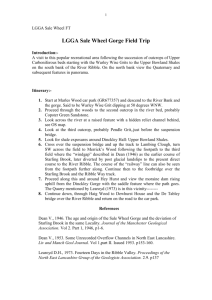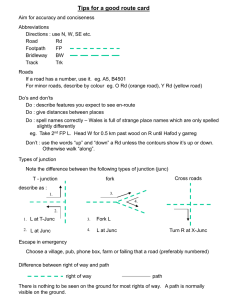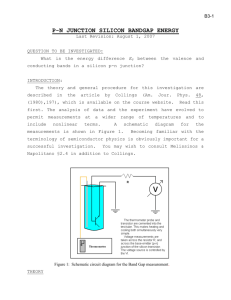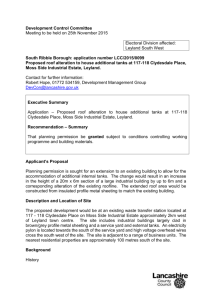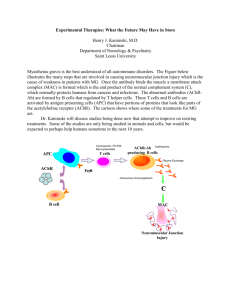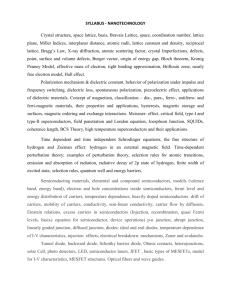Samelsbury Enterprise Zone
advertisement
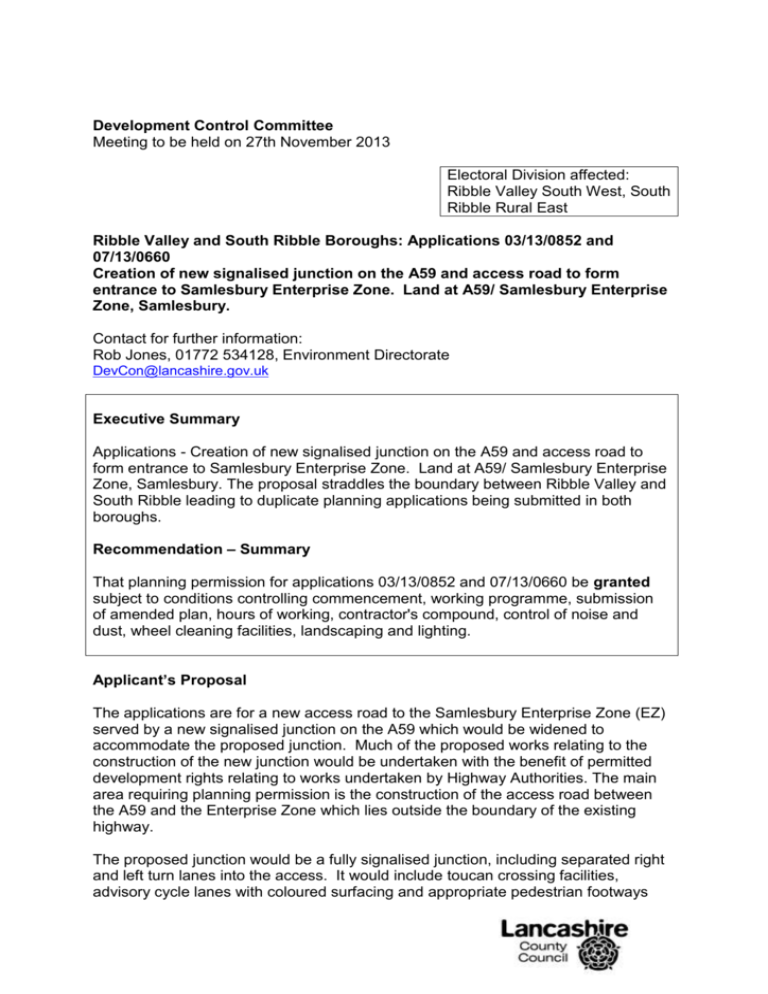
Development Control Committee Meeting to be held on 27th November 2013 Electoral Division affected: Ribble Valley South West, South Ribble Rural East Ribble Valley and South Ribble Boroughs: Applications 03/13/0852 and 07/13/0660 Creation of new signalised junction on the A59 and access road to form entrance to Samlesbury Enterprise Zone. Land at A59/ Samlesbury Enterprise Zone, Samlesbury. Contact for further information: Rob Jones, 01772 534128, Environment Directorate DevCon@lancashire.gov.uk Executive Summary Applications - Creation of new signalised junction on the A59 and access road to form entrance to Samlesbury Enterprise Zone. Land at A59/ Samlesbury Enterprise Zone, Samlesbury. The proposal straddles the boundary between Ribble Valley and South Ribble leading to duplicate planning applications being submitted in both boroughs. Recommendation – Summary That planning permission for applications 03/13/0852 and 07/13/0660 be granted subject to conditions controlling commencement, working programme, submission of amended plan, hours of working, contractor's compound, control of noise and dust, wheel cleaning facilities, landscaping and lighting. Applicant’s Proposal The applications are for a new access road to the Samlesbury Enterprise Zone (EZ) served by a new signalised junction on the A59 which would be widened to accommodate the proposed junction. Much of the proposed works relating to the construction of the new junction would be undertaken with the benefit of permitted development rights relating to works undertaken by Highway Authorities. The main area requiring planning permission is the construction of the access road between the A59 and the Enterprise Zone which lies outside the boundary of the existing highway. The proposed junction would be a fully signalised junction, including separated right and left turn lanes into the access. It would include toucan crossing facilities, advisory cycle lanes with coloured surfacing and appropriate pedestrian footways linking in with existing facilities. Footpaths and bus stops with shelters would be provided on both sides of the A59 adjacent to the proposed junction in lay-bys. The slip roads for traffic entering / leaving the new access road would be provided on the A59 leading onto and away from the new junction. The proposed access road would be approximately 65m long and 18m wide with 3m wide footpaths on either side. It is anticipated the construction period would be over a period of 20 weeks. The construction of the proposed junction would necessitate the removal of the screen bunding and associated tree planting on the north side of the A59 where it would be widened and on the south side of the A59 to facilitate the access road and slips roads. The proposed access is located within Ribble Valley Borough except for the southern tip of the access road forming the entrance to Samlesbury EZ that would be located within South Ribble Borough. Applications have been submitted for the development that falls within the respective authority boundaries. Description and Location of Site The proposed junction would be located on the A59 at Salmesbury between the existing BAE Systems access and Mellor Brook Roundabout, located 340m to the east. The new site access road would run between the south side of the A59 and across a small pasture area to dissect the end of Myerscough Smithy Road (which is a dead end and the old route of the A59) to join the existing entrance road to the east side of the BAE Systems site. Myerscough Smithy Road would be shortened but continue to be a dead end. The new junction would be 10m to the east of an existing private entrance road on the north side of the A59 that serves the residential properties of Sykes Holt and Carter Fold. The A59 would be widened on land either side of the private road and would involve removing the screen bunding and its tree planting in that location, as well as on the south side of the A59 in the vicinity of the access road. The A59 dissects the route of the Public Footpath No. 54 which joins the north side of the A59 from the private road, and the south side of the A59 through the screen bund. A section of the Ribble Valley cycle route is located on the old route of the A59 from the end of Myerscough Smithy Road to the A59. The nearest buildings to the development would be a brick built electricity substation and a security building that would be 20m and 35m to the east and west, respectively, of the access road. The nearest water body to the site would be a brick built/ concrete water tank located 45m to the south of the access road. Background History There is no relevant planning history. Planning Policy National Planning Policy Framework (NPPF) Paragraphs 11 – 14, 17 – 22, 28 – 29, 32, 34 – 36, 56, 64 – 66, 109, 111, 123 and 125 are relevant with regard to the requirement for sustainable development, core planning principles, building a strong and competitive economy, supporting a prosperous rural economy, promoting sustainable transport, good design and conserving and enhancing the natural environment. Ribble Valley Local Plan Policy G1 Policy G5 Policy G8 Policy ENV3 Policy ENV13 Policy EMP8 Policy T1 Policy T2 Policy T3 Policy T12 Policy T15 Development Control Land Outside Main Settlement/ Village Boundaries Environmental Considerations Open Countryside Landscape Protection Industry/ Employment Extensions and Expansions Development Proposal and Transport Road Hierarchy Primary Road Network Cycling Pedestrian Routes Ribble Valley Local Plan Submission Draft Core Strategy 2008-2028 Key Statement EC1 Business and Employment Development Policy DMG2 Strategic Considerations South Ribble Local Plan Policy EMP8 Employment Policy 8: Land at Samlesbury Aerodrome South Ribble Borough Council Submission Draft Site Allocations and Development Management Policies Development Plan Document (as modified) (June 2013) Policy C5 BAE Systems, Samlesbury Central Lancashire Core Strategy Policy 1 Policy 9 Policy 10 Locating Growth Economic Growth and Employment Employment Premises and Sites Consultation Draft Samlesbury EZ Master Plan Consultations Ribble Valley Borough Council – No observations received. South Ribble Borough Council – No objection as the development would facilitate the development of the Samlesbury EZ by providing an independent access off the A59. Consideration should be given to the design of the proposed junction to ensure it would be capable of handling the required capacity. Balderstone Parish Council - No observations received. Samlesbury Parish Council – No observations received. LCC Assistant Director (Highways) – No objection. Highways Agency – No objection. Environment Agency – No observations received. LCC Public Rights of Way – No objection. The development is adjacent to Public Footpath No. 54 Balderstone. The proposed development appears to improve access for pedestrians and would make crossing the A59 safer. Ramblers Association - No objection providing Footpath No. 54 is retained from the Mellor Brook Bypass to Myerscough Smithy Road. The proposed road crossing would make crossing the A59 much safer for those walking on Footpath No. 54. Representations – The application has been advertised by press and site notice and local residents informed by individual letter. Three representations have been received objecting to the proposal for the following summarised reasons: Safety Having two right turning lanes out of BAE with only a single carriageway for traffic to proceed onto would not be safe. The signalised main entrance on one side of the access, the Mellor Brook Roundabout on the other side of the access and with a bus stop in between, are in too close proximity. No provision has been made for a right turn and safe entry into Sykes Holt going west from the roundabout on the A59 at Mellor Brook, or for vehicles leaving Sykes Holt to turn west, especially those with trailers. This right turn and safe entry was granted when Sykes Holt gave up one entrance for the construction of the Mellor Brook Bypass. The junction and access road should be moved slightly to the east to incorporate the entrance to Sykes Holt and which should have its own set of traffic lights. This would then make it safer for all users of the Sykes Hole entrance whether travelling east or west. The development would result in a large increase in the number of vehicles on the local highway network from construction traffic and the users of the EZ. A large number would access the site along Branch Road in Mellor Brook and to the detriment of the village. The application is only for a new junction and access of the A59 when it should also include such provision off the A677 and, as such, a junction off the A677 may not happen and so the burden of traffic volume placed on the A59 would be both too much and unfair. Pedestrian, bike and public transport friendly issues The footways in the vicinity of the junction should be for shared use with adequate flush kerbs, to enable less confident cyclists to access the toucan crossings. In particular this is necessary for westbound cyclists on the A59 to avoid having to cross the left turn lane. The bus stop west of the junction should be orientated so that stopped buses do not stick out into the carriageway which would force cyclists to move out into the main traffic lanes. Suitable crossing provision should be made across the proposed access road for cyclists to navigate from the end of Myerscough Smithy Road to the off-road Ribble Valley cycle route. More provision should be made for more confident eastbound cyclists turning right into the new road and who choose to stay on the carriageway and not to use the toucan crossings by creating a specialist feeder lane for cyclists. Adequate provision needs to be made for cyclists to leave/join the carriageway to use the toucan crossings. Consideration should be given to providing a raised table across the side road entrance to Sykes Holt on the north side of the junction to improve the continuity of the footway. Advice Director of Transport and Environment – Observations Planning permission is sought to create a new signalised junction on the A59 and associated access road to form an entrance to the Samlesbury Enterprise Zone. Only the 65m length of proposed access road and the junction where it adjoins the A59 require planning permission. The works within the existing A59, such as the installation of traffic lights, and the widening of the north side of the A59, would be undertaken in the locale with the benefit of permitted development rights. Such rights allow development by highway authorities on land within the boundaries of a road required for the maintenance or improvement of the road, or on land outside but adjoining the boundary of an existing highway of works required for or incidental to the maintenance or improvement of the highway. In addition, that part of the access road within the Enterprise Zone will be permitted by the Lancashire Advanced Engineering and Manufacturing Enterprise Zone (Samlesbury) Local Development Order No.2 (2013), which is currently in preparation. In autumn 2011, the BAE Systems Samlesbury and Warton sites in Lancashire were granted EZ status. The Lancashire EZ has been created to become a major focal point for the advanced engineering and manufacturing sector. It is intended to support additional growth, create new businesses and new jobs through a combination of inward investment, specifically the introduction of new Tier 1 companies to the UK securing reinvestment, and the growth of small and medium sized enterprises (SME's) through technology spin-out businesses and new business starts. The EZ will aim to provide the opportunity to create 4,000 to 6,000 high value jobs in the long term and 1,200 jobs in the short to medium term, capitalising on new and emerging market opportunities in the advanced engineering and manufacturing sector. If successful, this should strengthen and grow local supply chains through modernisation of the sector in Lancashire and the UK, whilst providing a complementary offer to other national centres, such as the Advanced Manufacturing and Research Centre in Sheffield. Samlesbury EZ therefore forms a key element within a wider package of measures to provide land and the infrastructure for a variety of hi-tech sectors and so provide for economic growth and jobs. Its role and importance is recognised in key strategic priorities for the area and in key delivery mechanisms including the Preston, South Ribble and Lancashire City Deal. There will be two phases to the development of Samlesbury EZ. Phase 1 consists of the development of approximately 79,500m2 which is planned to commence in January 2014 and is anticipated to be in place by 2016. Traffic would access and egress the site from the A59. The proposed junction and access road the subject of this application would provide the road infrastructure by which the traffic generated at Phase 1 would arrive and depart from and onto the A59. The main issues associated with the application are if the purpose, location and design of the development are acceptable and in accordance with the policies of the development plan. Paragraphs 18 - 22 of the NPPF refers to the building of a strong and competitive economy and states that the Government is committed to securing economic growth in order to create jobs and prosperity, building on the country’s inherent strengths, and to meeting the twin challenges of global competition and of a low carbon future. The planning system should do everything it can to support sustainable economic growth and operate to encourage and not act as an impediment to sustainable growth. Therefore, the planning system should place significant weight on the need to support economic growth. To help achieve this, local planning authorities should plan proactively to meet the development needs of business and support an economy fit for the 21st century. Investment in business should not be overburdened by the combined requirements of planning policy expectations. Planning policies should recognise and seek to address potential barriers to investment, including infrastructure, and should avoid the long term protection of sites allocated for employment use where there is no reasonable prospect of a site being used for that purpose. Where there is no reasonable prospect of a site being used for the allocated employment use, applications for alternative uses of land or buildings should be treated on their merits having regard to market signals and the relative need for different land uses to support sustainable local communities. Paragraph 35 of the NPPF advises that developments should be located and designed where practical to accommodate the efficient delivery of goods and supplies; give priority to pedestrian and cycle movements, and have access to high quality public transport facilities; and create safe and secure layouts which minimise conflicts between traffic and cyclists or pedestrians, avoiding street clutter. Paragraph 111 advises planning decisions should encourage the effective use of land by re-using land that has been previously developed (brownfield land), provided that it is not of high environmental value. The proposed transport infrastructure would serve Samlesbury EZ that occupies land designated as Policy EMP8 of the South Ribble Local Plan that seeks to safeguard the land for operations in connection with the activities of British Aerospace. British Aerospace does not require the land any more but it will be developed for the advanced engineering and manufacturing sector. Policy EMP8 Ribble Valley Local Plan permits the expansion of existing firms on land outside main settlements provided it is essential to maintain the existing source of employment. Policies 1, 9 and 10 of the Central Lancashire Core Strategy have the BAE Systems Samlesbury site allocated as a strategic site for major development for economic growth and employment generation. The proposal is crucial to provide the road infrastructure for such major development and hence accords with Policy EMP8 of the South Ribble Local Plan, Policy EMP8 Ribble Valley Local Plan. The Ribble Valley Local Plan Submission Draft Core Strategy 2008-2028, South Ribble Borough Council Submission Draft Site Allocations and Development Management Policies Development Plan Document (DPD) (as modified) (June 2013) and the Consultation Draft Samlesbury EZ Master Plan are material and to which weight must be given when considering the proposal. Key Statement EC1 of the Ribble Valley Core Strategy identifies the support of the delivery of the Samlesbury EZ as a regionally significant employment site with considerable potential to accommodate a variety of advanced knowledge based industries in the future. Policy DMG2 of the Core Strategy requires development to be compatible with the EZ designation. Policy C5 of the South Ribble DPD supports the delivery of the EZ. The Consultation Draft Samlesbury EZ Master Plan seeks to address access to the Enterprise Zone and its integration to the existing public highway network and proposals for onsite/off site works required as a result of the development. The proposal is crucial to provide the road infrastructure for the major development of the Samlesbury EZ and hence accords with Policy EMP8 of the South Ribble Local Plan, Policy EMP8 Ribble Valley Local Plan, Policies 1, 9 and 10 of the Central Lancashire Core Strategy, Key Statement EC1. It would also accord with the emerging Policy DMG2 of the Ribble Valley Local Plan Submission Draft Core Strategy 2008-2028, Policy C5 of the South Ribble Borough Council Submission Draft Site Allocations and Development Management Policies Development Plan Document (DPD) (as modified) (June 2013), and the Consultation Draft Samlesbury EZ Master Plan. The proposed access road and junction are located on land designated as open countryside. The site is not the subject of a site specific policy but is the subject of general Policies G5 and ENV3 of the Ribble Valley Local Plan. Policy G5 supports small scale developments outside main settlement/ village boundaries subject to a number of criteria including those which are essential to the social well being of the area and other uses appropriate to a rural area which conform to the policies of this plan. Policy ENV3 supports proposals for development in the open countryside which are acceptable by virtue of their size, design, use of materials, landscaping and siting. Policy ENV13 seeks to mitigate for the loss of landscape features such as the removal of the tree planting on top of the screen bunding on the north and south sides of the A59. The 65m long access road and the associated junction are as minimal in size as they can be whilst achieving the required standards of road design and purpose they are intended to serve. To minimise impact, details of any lighting to be used, landscaping, replacement planting for the vegetation removed, protection of existing trees, details of the construction compound/s, hours of construction work to safeguard the amenity of local residents whilst helping to reduce the overall construction period and the requirement for the use of noise and dust suppression measures to be employed throughout the duration of the development can be required by condition. Subject to such conditions the proposal accords with Policies G5, G8, ENV3 and ENV13 of the Ribble Valley Local Plan. It is recognised that the Samlesbury EZ Phase 1 will generate significant levels of traffic that would have to access the site from the A59 so that the future Phase 2 can be accommodated in the southern side of the site. The proposed location of the road infrastructure has been chosen so as to be between but not interfere with the existing BAE Systems Access and Mellor Brook Roundabout junction and whilst enabling easy access to join the existing entrance road to the east side of the BAE Systems site, that will be the entrance to the EZ. A Transport Assessment (TA) for the proposed junction has been carried out that considers the traffic impacts on the local and surrounding highway network, in particular the impacts on the existing BAE Systems access and other nearby junctions. The BAE Systems proposed 'Core Development' traffic (based on the total number of staff/deliveries expected on site by 2016) has also been considered in the TA and which assumes that these vehicles will be split between the existing BAE Systems Main Gate on the A59 and the proposed junction built as part of Phase 1. The junction would have to be able accommodate the construction and operational traffic associated with Phase 1. In terms of operational traffic, it is expected that a total of 474 additional vehicles will arrive and depart the Enterprise Zone via the A59 in the AM peak (07.30-08.30), with an additional 440 arriving and departing in the PM peak (17.00-18.00). When Phase 2 is complete, it is expected that a total of 1,562 vehicles will arrive and depart the Enterprise Zone via the A59 and future A677 access during the AM peak, with 1,158 arriving and departing in the PM peak. The TA has determined the point at which the proposed junction and the other key junctions in the immediate area become close to or over capacity, therefore triggering the requirement for the additional junction from the A677 and/or improvements to the Swallow Hotel junction or M6 Junction 31. It has been estimated that the proposed junction would start to approach capacity in 2019 when the two way traffic flow through the junction is increased in the region of 1,082 trips during the AM peak hour period. The proposed junction is estimated to be operating over capacity in 2020 when the additional two way traffic flow through the junction reaches 1,236. These trigger points would indicate a requirement for an additional access and/or junction improvements. In addition to the proposed junction design changes, the TA has identified a number of additional mitigation measures that may be introduced to reduce the impact of the additional proposed traffic during peak periods, and has also described potential impacts and proposed mitigation measures within the nearby village of Mellor Brook. A number of objections have been received and improvement suggestions made in relation to the location and design of the proposed junction and access. The layout of the junction and number of lanes is determined by the predicted traffic flow and distribution from the final EZ layout, bearing in mind that there will also be a south entrance from the A677. The response to the safety concerns raised in the representations section above, are as follows: There would be two right turn lanes in an east direction (towards Clitheroe) whilst only one left turn in a west direction (towards Preston). This is not because the majority flow is towards Clitheroe but due to the operation of the signals where the left turn lane can run on green for longer (and so allow for the flow of more vehicles) than the right turn lanes. The submitted plan does show the two lanes on the A59 eastbound turning into a single carriageway when it should show the two lanes merging after 100m as per the layout design standards. An amended plan will be required to be submitted. The provision of the bus stop with potentially only 1 bus per hour stopping to be located between the signalised main entrance on one side and the Mellor Brook Roundabout is not considered to present a hazard. An amended plan has been submitted to provide a refuge for a right turn into the access for Sykes Holt and that would also provide a refuge for vehicles turning right (west) out of the access. The entrance to Sykes Holt cannot be incorporated into the junction as the land that would be required to move the junction and access road slightly to the east is not under the control of LCC, plus an electricity substation is sited upon it. There would be a significant cost and time delay involved in acquiring the land and moving the substation. This would unacceptably delay the commencement of the construction of both the proposed junction and access road and Phase 1 of the Samlesbury EZ. The Sykes Holt entrance is not to have its own set of traffic lights as it would interfere with the efficient running and flow of traffic at the junction. Instead, the property entrance will have an inductive-loop traffic detector system. It is inevitable that the construction of the proposed junction and access road will result in increased traffic on the local highway network. However, the development will be carried out over a temporary period and it is questionable how much construction traffic would use the local highway network. It is considered that the impacts associated with such would not justify the need for a legal agreement prescribing the routing of construction traffic. However, to ensure that construction vehicles would not pass through the nearby villages of Mellor and Mellor Brook the applicant (LCC) has advised that any contractual agreements will prevent construction vehicles from accessing the site via Mellor and Mellor Brook. The TA informs that the additional junction from the A677 will be constructed when the A59 junction is at its capacity. The response to the pedestrian, bike and public transport friendly issues raised in the representations section above, are as follows: The footways in the vicinity of the junction are to be shared use and the use of flush kerbs is County Council Standard. An amended plan will be submitted so that the bus stop west of the junction will be orientated so that stopped buses do not stick out into the carriageway and so not forcing cyclists to move out into the main traffic lanes. An amended plan will be submitted to provide for a suitable crossing across the proposed access road for cyclists to navigate from the end of Myerscough Smithy Road to the off-road Ribble Valley cycle route. There is not enough available space to create a specialist feeder lane for cyclists. Signage will clearly mark the off road crossing facility. An amended plan will be submitted to provide for a facility for cyclists to leave/join the carriageway to use the toucan crossings. It is considered inappropriate to provide a raised table across the entrance to Sykes Holt as it would cause issues with vehicles entering and egressing the entrance and so necessitating them to slow down where they could be vulnerable to traffic on the A59 or prohibiting comfortable acceleration out of the access creating similar vulnerability. The access only leads to two properties and is not a through route therefore the users would be familiar with the cycle provision as proposed. It is considered that the location and design of the proposed junction and access and the incorporation of cycle and pedestrian routes, along with the monitoring of traffic levels and the identified additional junction and/or improvements to other junctions, are acceptable. Details of the final design of the junction and access road can be required by condition. The planning application is supported by an ecological assessment (Extended Phase 1 Habitat Survey) that concludes there will be no direct impacts on protected species and buildings (substation, security building) they may use, and that semi-mature/ mature trees would be avoided. In line with the recommendations of the ecological assessment, the County Council's Specialist Advisor on Ecology has advised that if the proposal would impact on the trees and buildings (and that would include works within 15m of them, according to the ecology report), then further information (assessment of impacts on bats; mitigation proposals if bats would be affected) will be required prior to determination. The areas of more species-rich grassland (TN7 and TN9 on the phase 1 habitat map) should be adequately protected during construction and, if impacts are likely, then mitigation and compensation would be necessary. Precautions for the avoidance of impacts on nesting birds, and a procedure for the demolition of the nearby water tank given it may support amphibians can be required by condition. Similarly, details of lighting to ensure avoidance of light pollution/ light spill into woodlands and woodland edges (bat habitat) can be required by condition. In view of the scale, location and nature of the proposed development it is considered no Convention Rights as set out in the Human Rights Act 1998 would be affected. Recommendation That planning permission be granted subject to the following conditions: Time Limits 1. The development shall commence not later than 3 years from the date of this permission. Reason: Imposed pursuant to Section 91 (1) (a) of the Town and Country Planning Act 1990. 2. Written notification of the date of commencement of the development shall be made to the County Planning Authority within 7 days of such commencement. Reason: To enable the County Planning Authority to monitor the development to ensure compliance with this permission and to conform with Policies G1 and ENV3 of the Ribble Valley Local Plan. Working Programme 3. The development shall be carried out, except where modified by the conditions to this permission, in accordance with the following documents: a) The Planning Application received by the Director of Transport and Environment on 25th September 2013. b) Submitted Plans and documents received by the Director of Transport and Environment on 25th September 2013: Drawing No. CHA1E4101_003 - Ecology Plan Drawing No. CHA1E4101_003 - Cross Sections Drawing No. CHA1E4101_004 - Section Location Plan Submitted Plans and documents received by the Director of Transport and Environment on 17th October 2013: Drawing No. CHA1E4101_001 - Site Plan Interim c) All schemes and programmes approved in accordance with this permission. Reason: To minimise the impact of the development on the amenities of the local area, and to conform with Policies G1, G5, G8, ENV3, ENV13, EMP8, T1, T2, T3, T12 and T15 of the Ribble Valley Local Plan. 4. Within one month of the date of this permission, an amended site layout plan showing the two right turn lanes from the junction merging after 100m in an east direction on the A59, the re-orientation of the bus stop west of the junction so that stopped buses do not stick out into the carriageway and so not forcing cyclists to move out into the main traffic lanes, the provision for a suitable crossing across the proposed access road for cyclists to navigate from the end of Myerscough Smithy Road to the off-road Ribble Valley cycle route and for a facility for cyclists to leave/join the carriageway to use the toucan crossings, and any other changes to the design of the junction and access road, shall be submitted to the Director of Transport and Environment for approval in writing. Following approval the site shall be constructed in accordance with the approved details. Reason: For the avoidance of doubt and to enable the County Planning Authority to control the development and to minimise its impact on the amenities of the local area and to conform with Policies G1, G5, G8, ENV3, ENV13, EMP8, T1, T2, T3, T12 and T15 of the Ribble Valley Local Plan. Hours of Working 5. No ground engineering or construction development, delivery or removal of materials shall take place outside the hours of: 0730 to 1800 hours Monday to Friday (except Public Holidays), 0800 to 1700 hours on Saturday (except Public Holidays). No ground engineering or construction development, delivery or removal of materials shall take place at any time on Sundays or Public Holidays. This condition shall not however operate so as to prevent the carrying out, outside of these hours, of essential repairs to plant and machinery used on the site. Reason: To safeguard the amenity of local residents and adjacent properties/landowners and land users and to conform with Policy G8 of the Ribble Valley Local Plan. 6. Details of any construction compound shall be submitted to the County Planning Authority for approval in writing within one month of the date of this permission. The details shall include: a) The location and layout of a contractor's compound including contractor's car parking, demountable units and illumination of the site. b) Details for the routing and management of contractor's vehicles and construction traffic. c) Details for the restoration of the contractor's compound. The contractor's compound shall be constructed in accordance with the approved details. The compound shall be removed and the site restored in accordance with the details required by part c) to this condition within six months of the completion of the construction phase of the development. Reason: In the interests of highway safety and to minimise light spill beyond the site boundary to the surrounding houses and to safeguard local amenity and to conform with Policies G1, G8 and ENV13 of the Ribble Valley Local Plan. Control of Noise 7. All plant, equipment and machinery used in connection with the operation and maintenance of the site shall be equipped with effective silencing equipment or sound proofing equipment to the standard of design set out in the manufacturer's specification and shall be maintained in accordance with that specification at all times throughout the development. Reason: To safeguard the amenity of local residents and adjacent properties/landowners and land users and to conform with Policy G8 of the Ribble Valley Local Plan. Dust 8. All necessary measures shall be employed throughout the construction phase of the development, including the watering of the site storage and development areas to prevent the migration of dust from the site onto adjoining properties. Reason: To safeguard the amenity of local residents and adjacent properties/landowners and land users and to conform with Policy G8 of the Ribble Valley Local Plan. Highway Matters 9. Measures shall be taken at all times during the construction phase of the development to ensure that no mud, dust or deleterious material is tracked onto the public highway by vehicles leaving the site Reason: In the interests of highway safety and to safeguard the amenity of local residents and adjacent properties/landowners and land users and to conform with Policy G1 of the Ribble Valley Local Plan. Landscaping 10. A scheme and programme for the landscaping of the site shall be submitted to the County Planning Authority within one month of the commencement of development for approval in writing. The scheme and programme shall include details of: a) Identification of the existing trees and other vegetation that are to be retained and details of the measures for their protection. b) The location and layout of tree and shrub planting to compensate and replace for the vegetation removed to include species, types numbers, spacings, planting techniques and protection measures to offset the loss of semi-improved grassland. c) Details for the contours of the mounding adjacent to the A59 d) Details of mowing and management of grassed areas and weed control. e) Any hard landscaping areas including surfacing. The approved scheme and programme shall be implemented in its entirety. The planting shall be undertaken within the first available planting season following completion of the construction phase of the development. All trees and shrubs shall be protected from any damage and maintained for a period of five years including the replacement of any dead and dying trees or shrubs, weed control and maintenance of protection measures. Reason: In the interests of visual and local amenity and the local environment, and to conform with Policies G1 and ENV13 of the Ribble Valley Local Plan. 11. All hedges and trees forming part of the site boundaries or to be retained within the site shall be protected from any damage and maintained throughout the construction phase of the development. Reason: In the interests of visual and local amenity and the local environment and to conform with Policy G8 of the Ribble Local Plan. 12. No trees or hedgerows shall be removed during the bird-breeding season between 1 March and 31 July inclusive unless they have been previously checked and found clear of nesting birds in accordance with Natural England’s guidance and if appropriate, an exclusion zone set up around any vegetation to be protected. No work shall be undertaken within the exclusion zone until birds and any dependant young have vacated the area. Reason: To protect nesting birds and to conform with Policy G8 of the Ribble Valley Local Plan. 13. The development shall be carried out in accordance with the recommendations set out in the Extended Phase 1 Habitat Survey Report dated August 2013 by Pennine Ecological submitted with the application. Reason: In the interests of visual and local amenity and the local environment and to conform with Policy G8 of the Ribble Local Plan. Floodlighting 14. Prior to the commencement of development a scheme and programme for the lighting of the development shall be submitted to the County Planning Authority for approval in writing. The scheme and programme shall be designed to minimise light pollution/ light spill into the surrounding area including woodlands and woodland edges and shall include details of: a. b. c. d. e. Type and intensity of lights. Types of masking or baffle at head. Type, height and colour of lighting columns. Number and size of lighting units per column. Light spread diagrams showing lux levels at the site boundary and calculation of the impact of these on nearby residential properties. f. Phasing of the implementation of the approved scheme. Thereafter the lighting shall be erected and operated in accordance with the approved scheme and programme. Reason: To safeguard the amenity of local residents and adjacent properties/landowners and land users and to conform with Policy G8 of the Ribble Valley Local Plan. Definitions Planting Season: The period between 1 October in any one year and 31 March in the following year. Local Government (Access to Information) Act 1985 List of Background Papers Paper 03/13/0852 07/13/0660 Date Contact/Directorate/Ext 25 September 2013 25 September 2013 Rob Jones/Environment/34128 Reason for Inclusion in Part II, if appropriate N/A
